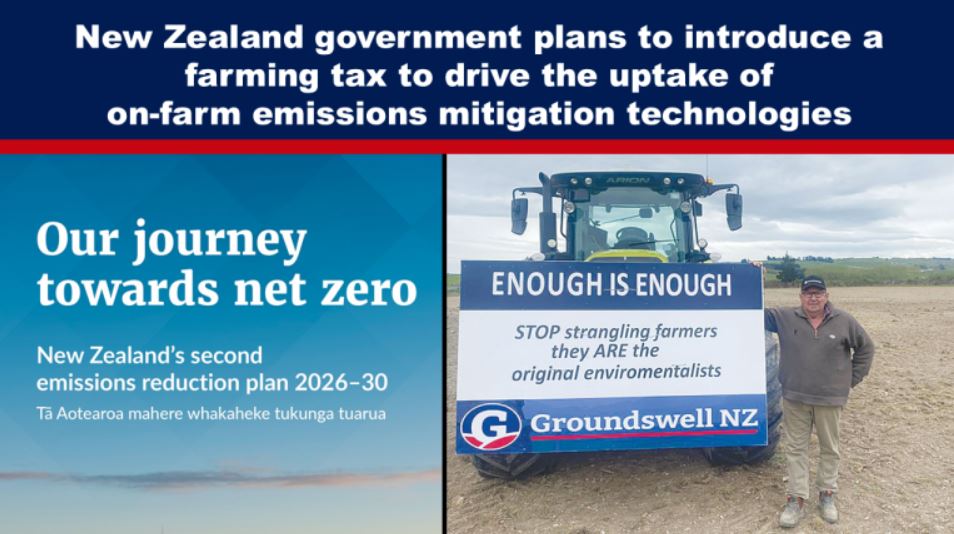Last week, the New Zealand government released its second emissions reduction plan for the years 2026 to 2030. The plan will see agricultural emissions pricing introduced by 2030 as “incentives” to take up new technologies.
Climate Change Minister Simon Watts claims the plan sets the foundation for meeting the government’s net zero 2050 target as early as 2044.
The New Zealand Government plans to introduce a farm-level levy on agricultural greenhouse gas emissions as early as January 2026. This initiative is part of the He Waka Eke Noa Primary Sector Climate Action Partnership, a partnership formed in 2019 between industry, Māori and the Government to develop a framework to measure, manage and reduce agricultural greenhouse gas emissions.
To act as stepping stones to achieve its 2050 emissions reduction targets, the New Zealand government will set out four emissions reduction plans (2022-25, 2026-30, 2031-35, 2036-40), including sector-specific emissions budgets. The Climate Change Commission monitors progress and reports annually on achievement towards reaching the 2050 target.
The first emissions reduction plan (2022-25) was published in May 2022. The second emissions reduction plan (2026-30) was published on 11 December 2024. This latest plan introduces a farming tax for on-farm emissions which, using psychologically manipulative language, the Government refers to as an “agricultural emissions pricing system.”
In October/November 2022, the Ministry for the Environment led a consultation on pricing agricultural emissions seeking feedback from farmers and growers on policy options. After the consultation, the New Zealand Government considered He Waka Eke Noa’s recommendations alongside advice from the Climate Change Commission to make final decisions on an agricultural emissions pricing system. Implementing these pricing systems is part of the Government’s second emissions plan which will come into effect on 1 January 2026.
Chapter 10 (page 56) of the second emissions plan (2026-30) details the war on farmers for the fictitious climate change crisis. It recognises the importance of agriculture to New Zealand, “Agriculture is a critical contributor to our economy and way of life, making up 81 per cent of merchandise exports and nearly 13 per cent of overall employment.” And then goes in for the attack, “Agriculture also makes up over 50 per cent of New Zealand’s gross emissions.”
Where are they focusing their attention? According to the emissions reduction plan (2026-30), agricultural emissions by activity include:
- 78.2 per cent from methane emissions produced by enteric fermentation – the digestive process of ruminant animals such as cattle, sheep and goats creating methane emissions
- 15.2 per cent from agricultural soils – mostly nitrous oxide generated by micro-organisms acting on nitrogen introduced via livestock urine, dung or synthetic fertilisers
- 4.6 per cent from manure management systems
- 2.2 per cent as carbon dioxide from other sources (including 2.1 per cent from urea application and liming, and 0.1 per cent from field burning of agricultural residues).
They are targeting nature and natural systems.
The Government is taking a multipronged approach to meeting its target, one of which suggests its estimation of emissions is more of a guesstimate:
- getting tools to farmers and growers faster, by investing in research, development and commercialisation,
- ensuring we have effective regulatory frameworks for new tools – here and internationally,
- better estimating on-farm emissions consistently across the country,
- supporting changes in practice on-farm,
- reviewing our methane science and target, and
- bringing in an on-farm emissions-pricing system by 2030.
The plan explains that the on-farm emissions pricing system they have devised aims to “reduce[ ] emissions without causing emissions leakage by sending production overseas.” The new jargon for shrinking the economy by destroying local agriculture is “emissions leakage.” You couldn’t make this up … but they can, obviously. You imagine New Zealand politicians trying to solve an unemployment and food insecurity crisis, “Oh dear, we have an emissions leakage to China. We should try to negotiate with China to try to get back some of our emissions.”
The plan admits that the primary aim of the emissions pricing system is to coerce farmers to take up mitigation technologies. “A system to price agricultural emissions is assumed to drive the uptake of mitigation technologies,” the plan states.
Mitigation technologies include breeding or genetically selecting livestock for “low emissions,” compounds to inhibit methane emissions from livestock digestive systems and a methane vaccine for ruminant animals. Bovaer is not mentioned as one of the proposed digestion disrupters but three other methane inhibitors are named.
They’re not only looking to subject animals to malnutrition and illness through the use of methane inhibitors in their gut and vaccines, but the climate loonies are also proposing fiddling with the pasture that livestock eat.
One of the proposals is, and try not to laugh, “An agricultural biotech company founded in New Zealand is using UV light to develop a low emissions farm pasture with higher productivity.” Perhaps they plan to stop chemtrail operations and allow the Sun to shine on the pastures? Not likely, there’s no money in natural sunlight for the biotechnology, or the chemtrail, industry.
Another suggestion is “a genetically modified ryegrass.” How nutritious is that going to be?
Another bizarre proposal is, again try not to laugh, a nitrification inhibitor to reduce nitrous oxide (N2O) from urine and dung deposited on pastures: “A potential novel inhibitor to target urine patches or be applied with fertiliser.” They fantasise this will reduce 30% of N2O from urine and dung. What will happen to the soil and insects that need the dung? What will happen to the birds and animals that eat the insects? And then what will happen to the animals that depend on birds as their food source? They don’t say.
Bryce McKenzie, a New Zealand farmer and co-founder of the farming advocacy group Groundswell NZ, is not impressed with the Government’s proposals either, but for different reasons. He says the plan will mean higher food prices for Kiwis with no benefit to global emissions.
“This Government, like the last one, is pretending there is some way a price on agricultural emissions – a Farming Tax – can work without making the food we produce in New Zealand more expensive and less competitive overseas, sending production offshore,” he said. He is referring to what the Government manipulatively calls “emissions leakage.”
The following is a press release published by Groundswell on 11 December in response to the second emissions reduction plan.
National Continues Farming Tax Delusion
By pretending emissions leakage can be wished away, National’s plan for a Farming Tax by 2030 is as fundamentally flawed as Labour’s old plan, Groundswell NZ co-founder Bryce McKenzie says.
“Put simply, Climate Change Minister Simon Watts’ delayed Farming Tax will mean even higher food prices for Kiwis who can’t afford it, with no benefit to global emissions.
“Supporting research into emissions reduction innovations is well and good, but Kiwi farmers are the most efficient in the world and already have strong incentives to hold that position by taking up new technologies once they are shown to be safe, effective and actually desired by consumers.
“This Government, like the last one, is pretending there is some way a price on agricultural emissions – a Farming Tax – can work without making the food we produce in New Zealand more expensive and less competitive overseas, sending production offshore.
“Any reduced production here will just be taken up by less efficient foreign farmers who emit more for the same amount of food and chop down rainforests to make room for their larger, less efficient herds and flocks.
“If the goal is decreasing the world’s total food emissions, the politicians clapping for Simon Watts at overseas conferences should be removing trade barriers so our lower-emissions food can compete fairly in their markets,” says Mr McKenzie.
Source: https://expose-news.com/2024/12/18/new-zealand-farming-tax-to-drive-the-uptake-of/
Bitchute: https://www.bitchut,e.com/channel/YBM3rvf5ydDM/
Telegram: https://t.me/Hopegirl587
EMF Protection Products: www.ftwproject.com
QEG Clean Energy Academy: www.cleanenergyacademy.com
Forbidden Tech Book: www.forbiddentech.website













